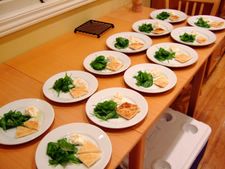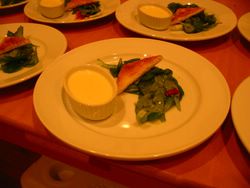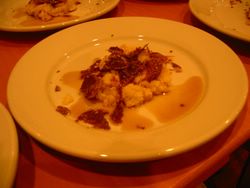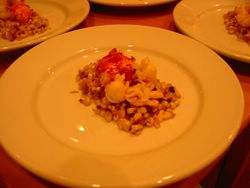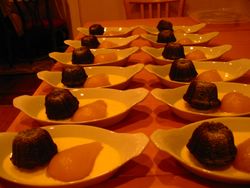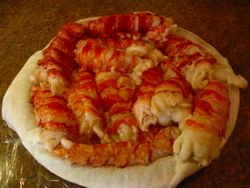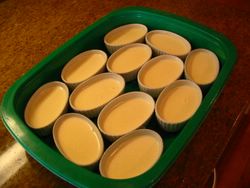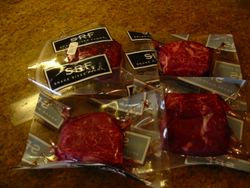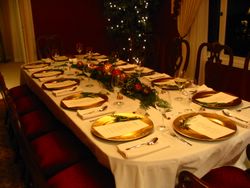White Truffle Dinner 2006: Course 6
This is the seventh in a series of posts directed to the Fourth Annual White Truffle Dinner that Rhonda and I recently held at my home. For more on the dinner, please see these posts: Introduction | Course 1 | Course 2 | Course 3 | Course 4 | Course 5 | Course 6 | Course 7 | Course 8 | Conclusion
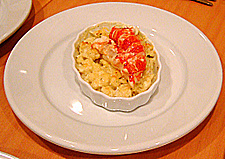 The sixth course for this year's White Truffle Dinner was Butter-Poached Maine Lobster with White Truffle Cauliflower Gratin. Prior to my first meal at The French Laundry in 2000, I had come to believe that lobster meat, by its very nature, is always somewhat tough. Like many people, I had spent my life eating lobster that had been cooked through boiling, a relatively violent method of preparation that tends to cause the meat to seize up. Nevertheless, the incredible flavor of this delicacy was always more than enough to compensate for any textural peculiarities. You can imagine my excitement, then, when Thomas Keller and his kitchen demonstrated that evening in 2000 that lobster meat does not have to have a rubbery consistency, that it can instead be tender, buttery and utterly sublime. Although the menu itself announced that the meat had been poached in butter, the precise details would remain unknown to me until a few years later, when I finally acquired a copy of the The French Laundry Cookbook. The secret, I would learn, is to gently cook the lobster in beurre monte -- butter melted in such a way that its component ingredients (fat, milk solids, and water) remain in an emulsified state. As I started the planning for our first White Truffle Dinner in 2003, one of the few things I knew for sure was that butter-poached lobster would have to hold a position of prominence on the menu. I described in an earlier post how much I also loved The French Laundry's white truffle risotto, but I wasn't thrilled with the idea of having that be the last course before dessert -- especially if the consequence was that something more substantial, like the lobster, would have to precede it. On that basis alone, I concluded that butter-poached lobster would serve as the sixth and final savory course on the menu, a distinction that it has held right up to this day.
The sixth course for this year's White Truffle Dinner was Butter-Poached Maine Lobster with White Truffle Cauliflower Gratin. Prior to my first meal at The French Laundry in 2000, I had come to believe that lobster meat, by its very nature, is always somewhat tough. Like many people, I had spent my life eating lobster that had been cooked through boiling, a relatively violent method of preparation that tends to cause the meat to seize up. Nevertheless, the incredible flavor of this delicacy was always more than enough to compensate for any textural peculiarities. You can imagine my excitement, then, when Thomas Keller and his kitchen demonstrated that evening in 2000 that lobster meat does not have to have a rubbery consistency, that it can instead be tender, buttery and utterly sublime. Although the menu itself announced that the meat had been poached in butter, the precise details would remain unknown to me until a few years later, when I finally acquired a copy of the The French Laundry Cookbook. The secret, I would learn, is to gently cook the lobster in beurre monte -- butter melted in such a way that its component ingredients (fat, milk solids, and water) remain in an emulsified state. As I started the planning for our first White Truffle Dinner in 2003, one of the few things I knew for sure was that butter-poached lobster would have to hold a position of prominence on the menu. I described in an earlier post how much I also loved The French Laundry's white truffle risotto, but I wasn't thrilled with the idea of having that be the last course before dessert -- especially if the consequence was that something more substantial, like the lobster, would have to precede it. On that basis alone, I concluded that butter-poached lobster would serve as the sixth and final savory course on the menu, a distinction that it has held right up to this day.
For the first three truffle dinners, I paired the lobster with a simple but satisfying accompaniment that I came up with several years ago, Truffled Sweet Corn & Shallots. The recipe for this couldn't be simpler: saute chopped shallots until translucent, add corn and saute for a few minutes more, and then season with kosher salt and white truffle oil. I've always been fond of serving shellfish with corn, so the idea of coupling my simple side dish with Thomas Keller's lobster came naturally. Because the combination was generally well received in those early years of our dinner, I probably would have been reluctant to drop it from this year's menu had it not been for one small factor: the corn and leek soup that I planned to serve as Course 1. Just as my desire to avoid repeating flavors had forced me to walk away from the creamed leeks that had previously been the mainstay of Course 4, so, too, would it demand that I abandon my corn and shallot dish.
 The loss of the corn made me briefly consider the possibility of replacing the lobster as well. When I came back to my senses, though, I began to wrestle in earnest with the question of what might step in to fill the void. An idea for doing an adult version of macaroni and cheese fizzled out when a recipe that looked promising on paper didn't deliver as hoped, while certain other vegetable options just didn't seem to spark my interest. Around the same time that I was mulling all of this over, I was also finalizing the menu for Thanksgiving dinner with my visiting parents. I settled on a Cauliflower Gratin as one of our side vegetables, based upon a recipe that I had tried once before from, you guessed it, Thomas Keller (only this time from his Bouchon cookbook). The core of the vegetable is cooked in herb-infused cream and then mixed with a pinch of curry powder, before being tossed with the florets and baked under a topping of panko and Comte cheese. The finished dish has a relatively mild yet luxuriously delicious flavor -- perfect, I figured, for featuring white truffle cream or oil. After confirming in my mind that lobster and cauliflower could complement each other well, the details of Course 6 were set.
The loss of the corn made me briefly consider the possibility of replacing the lobster as well. When I came back to my senses, though, I began to wrestle in earnest with the question of what might step in to fill the void. An idea for doing an adult version of macaroni and cheese fizzled out when a recipe that looked promising on paper didn't deliver as hoped, while certain other vegetable options just didn't seem to spark my interest. Around the same time that I was mulling all of this over, I was also finalizing the menu for Thanksgiving dinner with my visiting parents. I settled on a Cauliflower Gratin as one of our side vegetables, based upon a recipe that I had tried once before from, you guessed it, Thomas Keller (only this time from his Bouchon cookbook). The core of the vegetable is cooked in herb-infused cream and then mixed with a pinch of curry powder, before being tossed with the florets and baked under a topping of panko and Comte cheese. The finished dish has a relatively mild yet luxuriously delicious flavor -- perfect, I figured, for featuring white truffle cream or oil. After confirming in my mind that lobster and cauliflower could complement each other well, the details of Course 6 were set.
Preparing the beurre monte for poaching the lobster is always one of the most challenging tasks of our annual White Truffle Dinner. The technique itself is simple: bring 1 tablespoon of water to boil in a large pot, turn the heat down to medium, and then add butter -- a few tablespoons at a time -- while whisking continuously. The problem arises in that (a) a lot of butter (i.e., 4-6 cups) has to be melted in this manner in order to poach 10-12 lobster tails, and (b) it takes a quite a bit of time to get 12 sticks of butter completely melted down. It is theoretically possible, of course, to prepare the beurre monte in advance and then hold it until needed. But the emulsion will stay intact only if the temperature of the liquified butter is kept within a certain range, and that's something that even my Viking range had difficulty accomplishing the one year that I tried to make the beurre monte before our guests had even arrived. That evening, after having monitored the butter and adjusted the flame almost continuously throughout the preparation and service of the first five courses, I finally came to the moment of preparing to transfer the beurre monte to the pan containing the tails. I'm sure you can guess what happened next. That's right, the emulsion collapsed! I have since reverted to preparing the beurre monte real time, but I am still hopeful that I will someday find a better solution.
The cauliflower recipe requires 15 minutes of baking immediately before service in order to heat the mixture through and to brown the cheese. Rhonda and I accordingly put the individual gratin dishes into the preheated oven a few minutes before we started poaching the lobsters in the butter, so that the two would be done at approximately the same time. We positioned a finished tail on the top of each gratin, placed the entire gratin dish onto a larger plate, and set off for the dining table. As I sat down to join my guests, I breathed a sigh of relief; as you will see, the final two courses would be comprised of components that had been completed entirely in advance, so all of the challenging aspects of the evening were, at long last, over.
Finally, to give you a sense of how the menu has evolved over time, here's a summary of the Course 6 selections that we have served since the inaugural White Truffle Dinner in 2003:
 The sixth course for this year's White Truffle Dinner was Butter-Poached Maine Lobster with White Truffle Cauliflower Gratin. Prior to my first meal at The French Laundry in 2000, I had come to believe that lobster meat, by its very nature, is always somewhat tough. Like many people, I had spent my life eating lobster that had been cooked through boiling, a relatively violent method of preparation that tends to cause the meat to seize up. Nevertheless, the incredible flavor of this delicacy was always more than enough to compensate for any textural peculiarities. You can imagine my excitement, then, when Thomas Keller and his kitchen demonstrated that evening in 2000 that lobster meat does not have to have a rubbery consistency, that it can instead be tender, buttery and utterly sublime. Although the menu itself announced that the meat had been poached in butter, the precise details would remain unknown to me until a few years later, when I finally acquired a copy of the The French Laundry Cookbook. The secret, I would learn, is to gently cook the lobster in beurre monte -- butter melted in such a way that its component ingredients (fat, milk solids, and water) remain in an emulsified state. As I started the planning for our first White Truffle Dinner in 2003, one of the few things I knew for sure was that butter-poached lobster would have to hold a position of prominence on the menu. I described in an earlier post how much I also loved The French Laundry's white truffle risotto, but I wasn't thrilled with the idea of having that be the last course before dessert -- especially if the consequence was that something more substantial, like the lobster, would have to precede it. On that basis alone, I concluded that butter-poached lobster would serve as the sixth and final savory course on the menu, a distinction that it has held right up to this day.
The sixth course for this year's White Truffle Dinner was Butter-Poached Maine Lobster with White Truffle Cauliflower Gratin. Prior to my first meal at The French Laundry in 2000, I had come to believe that lobster meat, by its very nature, is always somewhat tough. Like many people, I had spent my life eating lobster that had been cooked through boiling, a relatively violent method of preparation that tends to cause the meat to seize up. Nevertheless, the incredible flavor of this delicacy was always more than enough to compensate for any textural peculiarities. You can imagine my excitement, then, when Thomas Keller and his kitchen demonstrated that evening in 2000 that lobster meat does not have to have a rubbery consistency, that it can instead be tender, buttery and utterly sublime. Although the menu itself announced that the meat had been poached in butter, the precise details would remain unknown to me until a few years later, when I finally acquired a copy of the The French Laundry Cookbook. The secret, I would learn, is to gently cook the lobster in beurre monte -- butter melted in such a way that its component ingredients (fat, milk solids, and water) remain in an emulsified state. As I started the planning for our first White Truffle Dinner in 2003, one of the few things I knew for sure was that butter-poached lobster would have to hold a position of prominence on the menu. I described in an earlier post how much I also loved The French Laundry's white truffle risotto, but I wasn't thrilled with the idea of having that be the last course before dessert -- especially if the consequence was that something more substantial, like the lobster, would have to precede it. On that basis alone, I concluded that butter-poached lobster would serve as the sixth and final savory course on the menu, a distinction that it has held right up to this day.For the first three truffle dinners, I paired the lobster with a simple but satisfying accompaniment that I came up with several years ago, Truffled Sweet Corn & Shallots. The recipe for this couldn't be simpler: saute chopped shallots until translucent, add corn and saute for a few minutes more, and then season with kosher salt and white truffle oil. I've always been fond of serving shellfish with corn, so the idea of coupling my simple side dish with Thomas Keller's lobster came naturally. Because the combination was generally well received in those early years of our dinner, I probably would have been reluctant to drop it from this year's menu had it not been for one small factor: the corn and leek soup that I planned to serve as Course 1. Just as my desire to avoid repeating flavors had forced me to walk away from the creamed leeks that had previously been the mainstay of Course 4, so, too, would it demand that I abandon my corn and shallot dish.
~ ~ ~ ~ ~
There's more...
 The loss of the corn made me briefly consider the possibility of replacing the lobster as well. When I came back to my senses, though, I began to wrestle in earnest with the question of what might step in to fill the void. An idea for doing an adult version of macaroni and cheese fizzled out when a recipe that looked promising on paper didn't deliver as hoped, while certain other vegetable options just didn't seem to spark my interest. Around the same time that I was mulling all of this over, I was also finalizing the menu for Thanksgiving dinner with my visiting parents. I settled on a Cauliflower Gratin as one of our side vegetables, based upon a recipe that I had tried once before from, you guessed it, Thomas Keller (only this time from his Bouchon cookbook). The core of the vegetable is cooked in herb-infused cream and then mixed with a pinch of curry powder, before being tossed with the florets and baked under a topping of panko and Comte cheese. The finished dish has a relatively mild yet luxuriously delicious flavor -- perfect, I figured, for featuring white truffle cream or oil. After confirming in my mind that lobster and cauliflower could complement each other well, the details of Course 6 were set.
The loss of the corn made me briefly consider the possibility of replacing the lobster as well. When I came back to my senses, though, I began to wrestle in earnest with the question of what might step in to fill the void. An idea for doing an adult version of macaroni and cheese fizzled out when a recipe that looked promising on paper didn't deliver as hoped, while certain other vegetable options just didn't seem to spark my interest. Around the same time that I was mulling all of this over, I was also finalizing the menu for Thanksgiving dinner with my visiting parents. I settled on a Cauliflower Gratin as one of our side vegetables, based upon a recipe that I had tried once before from, you guessed it, Thomas Keller (only this time from his Bouchon cookbook). The core of the vegetable is cooked in herb-infused cream and then mixed with a pinch of curry powder, before being tossed with the florets and baked under a topping of panko and Comte cheese. The finished dish has a relatively mild yet luxuriously delicious flavor -- perfect, I figured, for featuring white truffle cream or oil. After confirming in my mind that lobster and cauliflower could complement each other well, the details of Course 6 were set.Preparing the beurre monte for poaching the lobster is always one of the most challenging tasks of our annual White Truffle Dinner. The technique itself is simple: bring 1 tablespoon of water to boil in a large pot, turn the heat down to medium, and then add butter -- a few tablespoons at a time -- while whisking continuously. The problem arises in that (a) a lot of butter (i.e., 4-6 cups) has to be melted in this manner in order to poach 10-12 lobster tails, and (b) it takes a quite a bit of time to get 12 sticks of butter completely melted down. It is theoretically possible, of course, to prepare the beurre monte in advance and then hold it until needed. But the emulsion will stay intact only if the temperature of the liquified butter is kept within a certain range, and that's something that even my Viking range had difficulty accomplishing the one year that I tried to make the beurre monte before our guests had even arrived. That evening, after having monitored the butter and adjusted the flame almost continuously throughout the preparation and service of the first five courses, I finally came to the moment of preparing to transfer the beurre monte to the pan containing the tails. I'm sure you can guess what happened next. That's right, the emulsion collapsed! I have since reverted to preparing the beurre monte real time, but I am still hopeful that I will someday find a better solution.
The cauliflower recipe requires 15 minutes of baking immediately before service in order to heat the mixture through and to brown the cheese. Rhonda and I accordingly put the individual gratin dishes into the preheated oven a few minutes before we started poaching the lobsters in the butter, so that the two would be done at approximately the same time. We positioned a finished tail on the top of each gratin, placed the entire gratin dish onto a larger plate, and set off for the dining table. As I sat down to join my guests, I breathed a sigh of relief; as you will see, the final two courses would be comprised of components that had been completed entirely in advance, so all of the challenging aspects of the evening were, at long last, over.
Finally, to give you a sense of how the menu has evolved over time, here's a summary of the Course 6 selections that we have served since the inaugural White Truffle Dinner in 2003:
- Butter-Poached Maine Lobster with Truffled Sweet Corn & Shallots (2003)
- Butter-Poached Maine Lobster with Truffled Sweet Corn & Shallots (2004)
- Butter-Poached Maine Lobster with Truffled Sweet Corn & Shallots (2005)
- Butter-Poached Maine Lobster with Truffled Cauliflower Gratin (2006)










